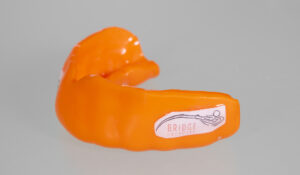A mouthguard for all seasons

We’ve all seen them in, and sometimes out of, the mouths of scores of athletes. Clear varieties are a staple, but it’s the bright greens, blues, team colors and logos that catch our glance. Even when players are on the bench, these mouthpieces seem to catch our attention even more as they’re spit down a jersey or looped around an ear.
One thing’s for sure: Mouthguards have staying power. If sports dentistry advocates like Dr. Danette McNew ’88, get their way, we’ll continue to see them in ever-increasing numbers.

Mouthguards are not new to athletics. In fact, the first variations surfaced back in the late 1860s when then-Cincinnati Red Stockings shortstop and catcher George Wright sported the device. Its popularity caught on; another Red Stockings player, Doug Allison, opted to wear one, too. His was saved as a team relic but was lost in a fire sometime after 1916.
The best variety nowadays: custom-fitted mouthguards fabricated with sophisticated machines that evenly heat the piece throughout. That way, the material doesn’t either unevenly clump or thin out over the front teeth. We’ve come a long way from the one-size-fits-all plastic mouthguards. Though they’re still available in most stores, these mouthguards are no longer the “go-to” option.
In actuality, mouthguards are getting “smarter,” says McNew, past president of the Academy for Sports Dentistry.
“The need for a consistent thickness is important in mouthguard protection, and that is why several team dentists have evolved different ways to produce a mouthguard for certain sports,” she explains.
“Intelligent” mouthguards with built-in circuit board sensors have been a part of the mix since 2009, allowing industry experts to evaluate impacts to the skull and teeth.
For example, mouthguards produced for basketball players often feature a thicker layer for teeth 6 to 11, followed by another layer of EVA — ethylene vinyl acetate — over the entire arch, versus two equal layers across the arch. “Intelligent” mouthguards with built-in circuit board sensors have been a part of the mix since 2009, allowing industry experts to evaluate impacts to the skull and teeth.
As 3D printing continues its expansion into dentistry, mouthguards are no exception. New models fabricated with this technology are currently in testing and development.
The call for mouthguards is supported by hard data.

According to a 2016 article in Dental Traumatology, 72.5% of dental injuries in high school sports occurred when the athlete was not wearing a mouthguard. The 2008 to 2014 data from the National High School Sports-Related Injury Surveillance Study further showed that, among athletes injured while wearing mouthguards, 95.9% of those devices were self-fitted. The risk is real: Injuries to the head or face exceeded 21% of all injuries sustained among U.S. high school athletes.
Collegiate athletes are likewise vulnerable. NCAA injury data from seven men’s sports and eight women’s sports between 2004 and 2014 reveals maxillofacial injuries represented about 3.4% of all athletic injuries, according to a 2017 study reported in Laryngoscope. While the number is low compared to other sports-related injuries, it signals an opportunity for prevention.
Even skateboarders, scooter riders or bicyclists can benefit from mouthguards, advocates say.
 “At my practice, my job is to inform patients and make parents aware they need this protection for their kids, from young athletes just goofing around in their driveway and having a mobile basketball goal fall down on their teeth to weight lifters clenching their teeth,” says McNew. “I always recommend they wear mouthguards to decrease dental injuries and excessive wear.”
“At my practice, my job is to inform patients and make parents aware they need this protection for their kids, from young athletes just goofing around in their driveway and having a mobile basketball goal fall down on their teeth to weight lifters clenching their teeth,” says McNew. “I always recommend they wear mouthguards to decrease dental injuries and excessive wear.”
The demand is constant. This is why, year-round, from flying-elbow favorites such as basketball to slow-and-steady summertime favorites like baseball, mouthguards are always in season.

This article originally appeared in the Fall/Winter 2019 Texas A&M Dentistry magazine